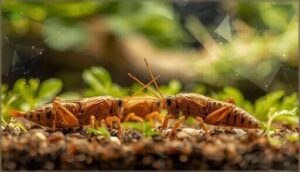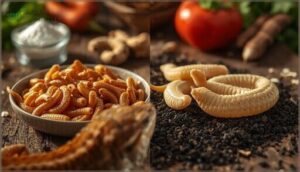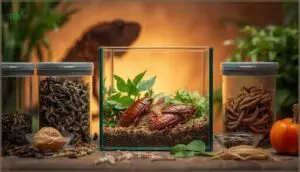This site is supported by our readers. We may earn a commission, at no cost to you, if you purchase through links.
Your bearded dragon eyes you with expectation at feeding time. But your local store ran out of crickets again. Finding reliable live reptile food shouldn’t feel like a treasure hunt.
Most reptile owners face this headache at least once a month when they need fresh feeders fast. The good news is you have more options than ever.
Local pet stores now stock diverse insects beyond basic crickets. Specialty reptile shops offer expert guidance on nutritional needs. Online retailers ship quality feeders straight to your door with guarantees.
This guide maps out where to buy live reptile food near you and online so your pets never miss a meal.
Table Of Contents
- Key Takeaways
- Where to Buy Live Reptile Food Near Me
- Online Retailers Offering Live Reptile Food
- Types of Live Feeder Insects Available
- Tips for Choosing The Right Live Reptile Food
- Convenient Shopping and Savings Options
- Frequently Asked Questions (FAQs)
- Where do you keep live reptile food?
- Does Petco have live reptiles?
- Why not buy reptiles from PetSmart?
- What foods are toxic to reptiles?
- What is the best way to store live feeders?
- Can I breed my own live reptile food?
- How often should I feed my reptile live food?
- Are live feeders suitable for all reptile species?
- Can I use wild insects as live reptile food?
- How do I store live feeder insects?
- Conclusion
Key Takeaways
- You can buy live reptile food from local pet stores, specialty reptile shops, national chains, or online retailers.
- Online platforms offer delivery, subscription savings, and guarantees for live insect orders, with cold weather shipping precautions.
- Crickets, mealworms, superworms, and Dubia roaches each have different nutritional benefits and storage needs for your pet.
- Always match feeder insect size and type to your reptile’s species, gut-load for nutrition, and avoid wild-caught insects due to health risks.
Where to Buy Live Reptile Food Near Me
Finding live reptile food doesn’t have to be complicated. You have several options right in your neighborhood and beyond.
Let’s look at where you can pick up fresh feeders for your reptile.
Local Pet Stores With Live Reptile Food
Your neighborhood pet stores often stock fresh live reptile food every week. You’ll find crickets, mealworms, and superworms in local pet services. Here’s what makes them reliable reptile food sources:
- Weekly insect variety deliveries keep feeders alive and healthy
- Store partnerships with trusted brands guarantee quality
- Freshness factors like controlled storage improve nutrition
- Expert advice helps match feeders to your pet
- Local availability means you can inspect before buying
The increasing demand for insect-based pet food is also driving this trend.
Reptile Specialty Stores in Your Area
Reptile specialty stores offer expert staff knowledge you won’t find everywhere. Over 1,200 stores across the U.S. carry rare species and live reptile food designed to your pet’s needs. You’ll discover community events, ethical sourcing standards, and reptile supplies from staff who understand your animal.
Florida and California host the most locations, making local pet services accessible. These pet store recommendations connect you with enthusiasts who share your passion. Many owners choose to feed their pets nutritious feeder insects to help provide a balanced diet.
National Pet Store Chains and Locations
PetSmart and Petco control over 70% of the market share for reptile supplies, operating more than 3,160 stores across North America. These chains offer geographic access through curbside pickup and same-day delivery, ensuring customers in all 50 states can find live crickets, mealworms, and other feeders.
Their supply chains import from 115 countries, though ecological impact concerns exist, particularly with wild-caught animals.
Online Retailers Offering Live Reptile Food
Online shopping has changed the game for reptile owners. You can now order live feeders from your couch and have them delivered right to your door.
Let’s look at the main platforms, shipping options, and subscription services that make feeding your reptile easier than ever.
Major Online Platforms for Live Feeders
Online pet shopping for live feeders has expanded dramatically, with platforms like Amazon and Chewy commanding roughly 60% of the U.S. market. You’ll find specialized retailers such as Josh’s Frogs, Dubia.com, and Rainbow Mealworms offering convenient online ordering and impressive feeder variety.
Key platforms worth comparing:
- Amazon – Broad selection with fast fulfillment
- Chewy – Subscription benefits and autoship discounts
- Josh’s Frogs – Species-specific feeders with strong customer reviews
- Dubia.com – Premium roach colonies and live insect sales
- Rainbow Mealworms – Bulk ordering and consistent quality
Delivery Options and Cold Weather Shipping
When winter arrives, cold weather shipping becomes critical for live pet food orders. Most online feeder insect sources suspend deliveries below 15°F and include insulated temperature packaging with heat packs in 95% of shipments.
Carrier delays at hubs like Memphis can impact timing.
Expect regional restrictions on certain species, shipping guarantees only under approved conditions, and DOA refunds within two business days of insect delivery.
Autoship and Subscription Services
You’ll save real money with autoship programs—up to 15% off each order. Subscription savings add up fast when you’re feeding multiple pets.
Flexible delivery lets you choose weekly or monthly insect frequency based on your reptile’s appetite. Customization options mean you can bundle crickets with roaches or pause shipments anytime.
This convenient site approach drives impressive customer retention, and online insect food sales through pet food delivery platforms like Reptilefoodcom keep your feeders arriving on schedule.
Types of Live Feeder Insects Available
You have several feeder insect options when shopping for live reptile food. Each type offers different nutritional benefits for your pet. Let’s look at the most popular choices and what they bring to the table.
Crickets and Their Nutritional Benefits
Crickets are a powerhouse among live insects for your reptile. They deliver 20-66% protein, supporting growth and tissue repair. Their fat composition stays low at 5-24%, making them ideal for juveniles.
Crickets also provide B vitamins, calcium, and other minerals that support bone health and metabolism. With 70-75% moisture content, they offer hydration value while their thin exoskeleton ensures easy digestion for most species.
Mealworms and Superworms
Mealworms and superworms are two of the most accessible live food options you’ll encounter. Both offer distinct nutritional profiles worth understanding before you make your choice.
- Mealworms pack 20% protein with 5.7% fiber, supporting digestion in smaller reptiles
- Superworms deliver 19.7% protein but contain nearly double the fat at 17.7%
- Both require gut-loading methods to boost their naturally low calcium levels
- Storage solutions differ—mealworms refrigerate well while superworms need warmer conditions
The calcium to phosphorus ratio sits at roughly 1:13 for both feeder insects, far below the ideal 2:1 your reptile needs. That’s why dusting becomes essential.
Digestive concerns arise with mealworms’ harder exoskeleton in juveniles, while superworms’ high fat content can lead to obesity if overfed. Reptile preferences often lean toward superworms due to their active movement, triggering natural hunting behaviors.
Dubia Roaches and Alternative Feeders
Dubia roaches stand out among live food choices with 20-25% protein and three times the calcium of superworms. Their soft bodies offer better insect digestibility compared to crickets, requiring fewer feeder insects per feeding.
Market trends show rising demand for these roaches due to their quiet nature and minimal odor.
Alternative feeders like black soldier fly larvae provide high calcium, while grasshoppers deliver variable nutrition—though Dubia advantages remain unequaled.
Tips for Choosing The Right Live Reptile Food
Picking the right live food for your reptile isn’t just about grabbing what’s available. Different species need different feeders based on their size, hunting style, and nutritional requirements.
Let’s look at how to match your reptile with the best feeder insects and keep them healthy.
Matching Feeder Insects to Your Reptile Species
Your reptile’s species determines which feeder insects you should buy. Insectivorous chameleons need gut-loaded crickets and Dubia roaches 4-5 times weekly, while herbivorous iguanas require no live insects at all. Omnivorous bearded dragons thrive on 30-40% insects and 60-70% greens.
Match feeder insect size to the space between your reptile’s eyes to prevent choking. Rotating live insects prevents nutritional deficiencies and dietary restrictions from mono-feeding.
Understanding Nutritional Value of Feeders
You need to know the nutritional value of live insects before feeding them. Protein content varies widely—locusts deliver 61.7% protein while superworms offer just 17.4%. Mealworms pack 35% fat for energy, but earthworms supply only 5.8%.
Most feeders have poor calcium-phosphorus ratios (crickets at 0.3:1), so you’ll need supplements. Black soldier fly larvae naturally provide a 2.5:1 ratio without dusting.
Gut-Loading and Supplementation Advice
Knowing nutritional value is just the start—proper gut-loading and supplementation make those nutrients work. Feed your insects dark leafy greens, carrots, or commercial gut-load diets 24-48 hours before offering them. This timing matters because nutrient levels drop after two days.
- Dust insects with calcium powder right before feeding
- Use water gels to keep feeders hydrated
- Rotate gut-loading foods for balanced vitamins
- Try Vita-Bug Crickets for pre-loaded nutrition
- Prevent metabolic bone disease through consistent supplementation
Convenient Shopping and Savings Options
Getting live reptile food doesn’t have to be a hassle. Many retailers now offer flexible shopping methods that save you time and money.
Let’s look at the most convenient ways to get feeders delivered or picked up quickly.
In-Store Pickup and Curbside Pickup
When you order feeder insects online, pickup options save time and reduce stress. In-store and curbside pickup services offer convenience while maintaining insect quality in temperature-controlled bins. Scheduled pickup windows ensure your reptile food is ready when you arrive.
Pickup order accuracy has improved considerably, with reduced missed pickups boosting satisfaction rates. Brooklyn pet stores and local retailers now make getting fresh supplies easier than ever.
Same-Day Delivery Services
When speed matters, same-day delivery services bring live insects straight to your door. PetSmart partners with DoorDash to deliver feeder insects in most metro areas, while Pet Supermarket offers fast regional options. Here’s what you should
Discounts and Customer Support for Live Feeders
Many online retailers offer bulk discounts up to 70% on live feeders. You’ll find loyalty programs that save 5-15% through autoship, plus seasonal promotions averaging 8-12% off.
Check refund policies for live arrival guarantees—most resolve claims within 48 hours.
Quality suppliers maintain strong service metrics with 90%+ satisfaction ratings and multiple support channels for your online ordering needs.
Frequently Asked Questions (FAQs)
Where do you keep live reptile food?
Proper reptile food storage can extend mealworm life up to 10 weeks. You’ll need smooth-sided glass or plastic containers with secure lids and air holes.
Temperature control matters—mealworms need refrigeration at 45–50°F, while superworms require room temperature around 75°F.
Does Petco have live reptiles?
Yes, Petco sells live reptiles, including bearded dragons, leopard geckos, and ball pythons. Species availability varies by location.
You’ll also find pet supplies like feeders and habitat accessories for reptile care.
Why not buy reptiles from PetSmart?
You should avoid buying reptiles from pet shop chains due to animal welfare concerns. Investigations link suppliers to poor conditions, high mortality, and public health risks like Salmonella.
What foods are toxic to reptiles?
Toxic foods include avocados, citrus fruits, and fireflies. Chemical contaminants on insects pose serious dietary risks. Don’t feed wild-caught prey or pesticide-exposed feeders.
Proper reptile nutrition requires understanding which foods harm your pet’s health.
What is the best way to store live feeders?
Keep live food healthy by controlling temperature and humidity levels. Use ventilated containers and match substrate choice to each feeder insect.
Clean weekly to prevent mold and odor. Gut-load live insects for better nutrition before feeding your reptiles.
Can I breed my own live reptile food?
You can breed your own live food, like crickets or Dubia roaches, right at home. It’s a practical solution with economic benefits, but breeding challenges and nutritional considerations for feeder insects require careful insect nutrition and colony management.
How often should I feed my reptile live food?
Think of your reptile’s feeding frequency like tuning an instrument—juveniles need live insects daily, adults less often.
Match prey variety to age and metabolic rates, and get veterinary advice to fine-tune your reptile diet and health.
Are live feeders suitable for all reptile species?
Live feeders aren’t right for every reptile. Some species have strict Dietary Restrictions or unique Nutritional Needs. Herbivores, for example, need plants, not insects.
Always consider Health Risks, Feeding Enrichment, and Supplementation Necessities when planning your reptile’s diet.
Can I use wild insects as live reptile food?
You shouldn’t use wild insects as live reptile food. Wild insect risks include pesticide exposure, nutritional inconsistency, and disease spread. Collection challenges make it hard to avoid toxic or contaminated bugs.
Commercial feeder insects offer safer, reliable live insect nutrition.
How do I store live feeder insects?
Storing feeder insects is like tending a tiny farm. Use a cricket enclosure setup with egg crates for hiding, control temperature, and prevent escapes.
Roach hydration methods use water crystals. Mealworm substrate options include wheat bran.
Keep insect diet fresh.
Conclusion
Sometimes the easiest solution is the one you’ve overlooked. Finding where to buy live reptile food near me can feel tricky, but the answer is often close—at your local shop or just a click away.
Your pet’s health depends on reliable nutrition, not luck. With each feeder choice, you’re building trust and safety for your reptile.
When you know your options, feeding time becomes routine, not a race. Your journey ends with confidence, not uncertainty.
- https://www.thebusinessresearchcompany.com/report/small-mammal-and-reptile-food-global-market-report
- https://www.cognitivemarketresearch.com/reptile-amphibian-food-market-report
- https://www.accio.com/business/reptile-trends
- https://www.freedoniagroup.com/packaged-facts/pet-reptile-products-us-pet-market-trends-and-opportunities
- https://www.petfoodindustry.com/news-newsletters/pet-food-news/article/15541693/reptile-food-humanization-relevant-as-younger-owners-increase













